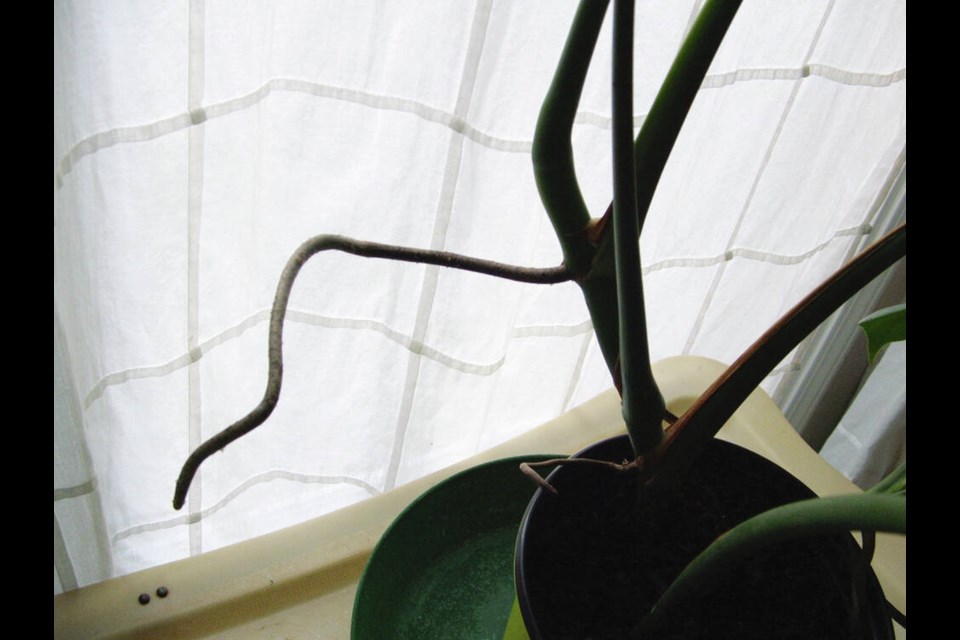Dear Helen: A split-leaf philodendron I was given in the spring has now produced long, odd-looking shoots that I’m told are “aerial roots.” Do they have a purpose? Should I be doing anything with them?
O.P.
Split-leaf philodendron (Monstera deliciosa, Swiss-cheese plant) is native to tropical forests where it has a climbing habit, growing up into forest trees toward brighter light.
As the plants climb, they produce aerial roots that clasp onto the host trees, securing the vines in place. Other aerial roots grow very long and hang down from the plant. Some reach the ground and root into the forest floor to absorb moisture and nutrients that sustain the vine.
People who dislike the look of aerial roots on their houseplant can cut them off cleanly at their point of origin. Or, provide a moss pole for them to cling to. Aerial roots that are situated appropriately and reach the right length can be pushed into the plant’s soil to root and help nourish the plant.
Most people with Monstera deliciosa plants simply leave the aerial roots, accepting them as part of the plant’s natural habit.
Dear Helen: My one female kiwi fruit vine, as usual, produced a heavy crop this year, but when I went to pick them around three weeks ago only one was left. What could have happened? I’ve never seen the squirrels around her take an interest in them.
M.H.
Squirrels are still the most likely culprits. Raccoons are another possibility, and rats, but both of them tend to leave feeding messes behind them, while squirrels gather and hoard food items.
It is not uncommon for a crop to stay untouched by pests and predators for many years before being discovered, and damaged or lost.
If your kiwi vines are situated apart from other plants and nearby structures, next fall you might consider wrapping the trunks and any support posts in 60-cm wide sheet metal collars. This is not effective if there are other routes that squirrels can take to access the fruit.
Regular monitoring of the fruit on the vines from mid-autumn onward would probably give you some indication of initial kiwi losses. Once that is noticed, an early picking might be in order. Once fruit-loving predators have taken a harvest from a plant, they are almost sure to return.
Dear Helen: An elderly aunt, once an avid food gardener, is now restricted to gardening within the confines of her apartment. I would love to find for her a gift that might spark her interest and bring her pleasure in growing things again.
R.I.
You’ll find several interesting possibilities in your local garden centres. Many will have kits for producing nutritious sprouts — alfalfa, mung beans and others.
Since your aunt has a history of growing food outdoors, equipment for producing microgreens might be even more appealing. Microgreens are grown in soil, in shallow pots or flats. Kale, amaranth, arugula, broccoli, sunflower and peas are popular microgreens. There are books on growing them. The one I have, by Fionna Hill, has recipes and is full of appealing colour photographs.
Herb growing kits are popular. They usually comprise a tray, pots and seeds for growing several herbs. Or, find herb seeds you think your aunt might like and assemble the rest of what she will need yourself. Don’t forget potting mix.
For sheer spirit-lifting, consider also an interesting and perhaps unusual seasonal gift plant. Some garden centres bring in such plants at this time of year.
Dear Helen: You occasionally recommend using local organic farms and farmers’ markets as sources of the foods we can’t grow ourselves. Are prices not a concern?
F.G.
I know I’m paying a premium for high quality, organically grown food, and I’m acutely aware that its price will be beyond the reach of the most financially struggling people, but I’m willing to forgo purchases and activities others might consider essential to afford it.
High quality, nutrient-dense food is, in my view, an essential to robust good health, Buying from local organic growers is also an investment in the health of the land and its future productivity — an investment that may be more important than we realize, considering the plight of places that supply so much of our food. Drought is a big issue in California, and no one knows yet what seeding and growing will be possible in the Fraser Valley next year.



